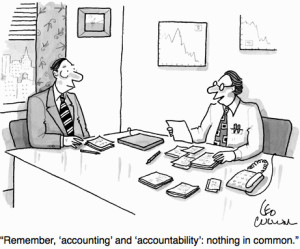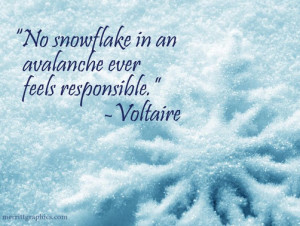What first crosses your mind when you hear “accountability?” I usually get two reactions: that there isn’t enough of it, or a wary reaction. Unfortunately, both reactions often reflect reality. We encounter organizations with products, services or results that fall short, with no one taking responsibility to close the gaps. When accountability comes up in organizations, a common reaction is preparation for blaming, shaming, increased performance pressure or all three.
It doesn’t have to be that way; ideally accountability is a positive, proactive dimension of an organization’s culture that everyone owns and takes pride in vs. a reactionary, negative or punitive dynamic. Here are the keys:
Lay the foundation. Part of laying the foundation is embracing accountability as a core value. As with other core values, this works when it’s defined, discussed on regular occasions and modeled, especially by leadership. Defining values is important, since they are interpreted differently; agreeing on “what we will do” and “what we won’t do” for any given value helps build common understanding.
Critical to a proper foundation for accountability is clarifying realistic goals and performance expectations. Research tells us that on average only about 40% of employees even know their organization’s strategic goals, so communicating those effectively is a  start. We also need to ensure that organization sub-units and team members have realistic goals and performance objectives, along with an understanding of how they contribute to larger goals. I mentioned “realistic” twice here, since I encounter both performance shortfalls and dispirited workers because that is not the case. Goals and performance objectives that are jointly crafted improve their realism and ownership, and therefore chances that they will be achieved. (“Jointly crafted” usually entails some negotiation, or give-and-take, not being forced to take goals that we are given.)
start. We also need to ensure that organization sub-units and team members have realistic goals and performance objectives, along with an understanding of how they contribute to larger goals. I mentioned “realistic” twice here, since I encounter both performance shortfalls and dispirited workers because that is not the case. Goals and performance objectives that are jointly crafted improve their realism and ownership, and therefore chances that they will be achieved. (“Jointly crafted” usually entails some negotiation, or give-and-take, not being forced to take goals that we are given.)
Clarify roles and responsibilities. A common cause of poor execution and accountability is uncertainty about roles and decision rights. We can be hesitant to act or make decisions on our own if we are not sure about what responsibilities are ours and what level of autonomy or what decision-making authority we have been granted.
Accountability for shared goals. We need to cultivate a “see it, own it, solve it and do it” orientation in our organizations, as “The Oz Principle” authors put it. That means that even if not in our job description or on our list of personal objectives, doing whatever needs doing to achieve the larger organization’s commitments and aspirations. We have a neighbor dedicated to picking up any trash or stray objects over several square blocks; it’s not his job, but a sense of responsibility that he feels as part of the community. It’s the same spirit that prevails when we correct an oversight, deliver extra customer service or help solve a problem that’s not of our making or our responsibility.
Cultivate authenticity. Authentic means real. One measure of reality already mentioned is the realism of goals and performance expectations. Another important facet is authentic communication. A truth-telling culture will of course help ensure realistic goal-setting; it will also facilitate difficult but necessary conversations when things are off course. We need leaders and team  members with the competence and courage to respectfully tell the truth as they see it and who empower others to do the same. Multiple incidents of not revealing “inconvenient truths” and not speaking truth to power or pressure were principle contributors to the l986 loss of the Challenger space shuttle with seven aboard, to name one classic and tragic example. If we are seeking to fix accountability for causes of our last great recession or companies that find themselves in ethical quagmires today, we will find countless instances of inability to be authentic or to speak the truth.
members with the competence and courage to respectfully tell the truth as they see it and who empower others to do the same. Multiple incidents of not revealing “inconvenient truths” and not speaking truth to power or pressure were principle contributors to the l986 loss of the Challenger space shuttle with seven aboard, to name one classic and tragic example. If we are seeking to fix accountability for causes of our last great recession or companies that find themselves in ethical quagmires today, we will find countless instances of inability to be authentic or to speak the truth.
Provide necessary support and resources. As psychologist and author Bob Mager pointed out, there are generally 4 reasons that people don’t perform: they don’t know what, they don’t know how, they don’t want to or there are barriers. Agreement on goals and performance expectations takes care of knowing what; training and coaching will help assure that they know how. Mager’s classic question to determine if lack of training causes performance gaps is: “Could they perform as desired if a gun were put to their head?” Short of that, testing, observing performance and coaching can help reveal if training support is needed. If we’ve ruled out lack of knowing what to do, how to do it or lack of motivation as issues, there likely are barriers to contend with, including perhaps insufficient resources, lack of collaboration, restrictive policies or physical barriers. An important part of our job as leaders is removing barriers.
Alignment. Upton Sinclair was right: “It’s hard to get someone to understand something when their pay depends on not understanding it.” We need to align pay, as well as recognition, measures, feedback, training and organizational systems with what we want people to be accountable for. If we want call center workers to be motivated about excellent customer service and accountable for it, reinforcing solely call volume won’t work. If we want to reinforce shared accountability regardless of role, it doesn’t work to neglect recognition of contributions outside the scope of team members’ job descriptions or goals.
Measure what matters. What do we want people to be accountable for? Likely it’s a combination of what to accomplish (goals and performance objectives themselves,) along with how (values and performance standards.) Agree on what measures or indicators will reflect that things are on course, and use those measures all along the way. Don’t fall into the trap of legendary ancient Roman bridge engineers, required to stand beneath a stone bridge’s capstone as it was put in place and chariots drove overhead. Don’t rely on just “lagging indicators” (dead engineers) to determine if goals were achieved; use “leading indicators” (process measures, stress indicators, etc.) to determine if corrective action is needed along the way.
will reflect that things are on course, and use those measures all along the way. Don’t fall into the trap of legendary ancient Roman bridge engineers, required to stand beneath a stone bridge’s capstone as it was put in place and chariots drove overhead. Don’t rely on just “lagging indicators” (dead engineers) to determine if goals were achieved; use “leading indicators” (process measures, stress indicators, etc.) to determine if corrective action is needed along the way.
If accountability matters, then we should measure it. Following are a few questions from inTEgro’s Organizational Integrity Survey to help you gauge accountability in your organization. Take a few moments to answer these questions:
KEY:
1 = Not at all characteristic 4 = Very characteristic
2 = Slightly characteristic 5 = Completely characteristic
3 = Fairly characteristic DK = Don’t know
- This organization achieves the goals that it sets.
- This organization uses a balanced set of measures to assess how it is doing–not just financial performance, but other measures that are important.
- This organization consistently provides data and timely feedback about performance and achievement of goals.
- This organization considers the impact that its decisions and actions will have on other stakeholders.
- People in this organization understand what measures are most important.
- This organization follows through with its commitments and plans.
- This organization provides products or services that deliver real value.
- This organization is a good steward of the resources it controls.
- This organization acts in ways that demonstrate it is a good community citizen.
- People in this organization are held accountable for their performance.
How is your organization doing? Less than 35 usually indicates accountability shortfalls; individual question responses can help identify where improvement is needed.
There is a broader than traditional notion of accountability reflected by several of the questions above: stewardship. Think of three concentric circles. Responsibility is the innermost circle – those things that we are charged with or assume responsibility for. Accountability is the next tier, and closer to The Oz Principle’s “see it, own it, solve it, do it” notion – shared ownership of larger organization or community goals and aspirations. Stewardship is a broader yet form of accountability and encompasses the outermost circle; it extends beyond our individual responsibilities and beyond even shared goals of our organization or community. Stewardship is consideration and care for resources and stakeholders that traditionally we are not held accountable  for. It is akin to “seventh generation thinking” attributed to early Native American cultures, conscious of how their resource use, decisions and practices might affect their grandchildren’s grandchildren and beyond. Quoting Voltaire, the comedian George Burns quipped that “No snowflake feels responsible for an avalanche.” Likewise, if there is not a sense of shared responsibility for resolving growing environmental, social, political and economic ills, they may overwhelm us; stewardship reflects that kind of shared responsibility. It is also about stewardship not only of financial and physical resources that can be easily counted, but of less tangible resources including reputation, employee wellbeing and talent. Consumers, employees and applicants are increasingly favoring organizations that demonstrate that kind of stewardship and social responsibility. Savvy organizations are becoming genuinely better stewards not only because it’s the right thing to do, but the more profitable and sustainable path.
for. It is akin to “seventh generation thinking” attributed to early Native American cultures, conscious of how their resource use, decisions and practices might affect their grandchildren’s grandchildren and beyond. Quoting Voltaire, the comedian George Burns quipped that “No snowflake feels responsible for an avalanche.” Likewise, if there is not a sense of shared responsibility for resolving growing environmental, social, political and economic ills, they may overwhelm us; stewardship reflects that kind of shared responsibility. It is also about stewardship not only of financial and physical resources that can be easily counted, but of less tangible resources including reputation, employee wellbeing and talent. Consumers, employees and applicants are increasingly favoring organizations that demonstrate that kind of stewardship and social responsibility. Savvy organizations are becoming genuinely better stewards not only because it’s the right thing to do, but the more profitable and sustainable path.
We wish you the best cultivating the accountability that is fundamental for what inTEgro calls “triple-E” leadership and cultures: leadership practices and organizational cultures that are effective, engaging and ethical.
The key to growth is to learn to make promises and to keep them.
Stephen R. Covey
It is not only what we do, but what we do not do, for which we are accountable.
Moliere
Many of the things you can count don’t count. Many of the things you cannot count really count.
Albert Einstein





